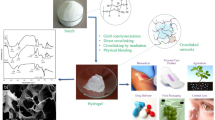Abstract
Gels of collagen hydrolysate (H) crosslinked with dialdehyde starch (DAS) are marked by a strong tendency to aging, which means a certain problem during their processing into biodegradable packaging materials. Applying casting technology and drying these materials by heating air-dry films and foils for a limited time (1–4 h) at 105 °C may eliminate the aging problem. Solubility of heat-treated films in an aqueous environment remains preserved, but depending on how long this temperature acts and on the DAS content in the film, time of film disintegration prolongs from 1–1.5 h to 1300 h (≈54 days). It is probably caused by the functional groups initially blocked by sorbed water, which get released to produce hydrogen inter-chain crosslinks. The decrease in glass transition temperature (T g) of such films varies with content of water sorbed in films in an interval of 90.2–189 °C.




Similar content being viewed by others
References
Kolomaznik K, Mladek M, Langmaier F, Janacova D, Taylor MM. Experience in industrial practice of enzymatic dechromation of chrome shavings. J Am Leather Chem Assoc. 2000;95:55–63.
Langmaier F, Kolomaznik K, Mladek M. Products of enzymatic decomposition of chrome-tanned leather waste. J Soc Leather Technol Chem. 1999;83:187–95.
Langmaier F, Mokrejs P, Kolomaznik K, Mladek M. Biodegradable packing materials from hydrolysates of collagen waste proteins. Waste Manage. 2008;28:549–56.
Draye JP, Delaey B, van de Woorde A, van den Bulcke A, Bogdanov B, Schacht E. In vitro release characteristics of bioactive molecules from dextran dialdehyde cross-linked gelatin hydrogel films. Biomaterials. 1998;19:99–107.
Langmaier F, Mladek M, Mokrejs P, Kolomaznik K. Biodegradable packing materials based on waste collagen hydrolysate cured with dialdehyde starch. J Therm Anal Calorim. 2008;93:547–52.
Jones BE. Manufacture and properties of two-piece hard capsules. In: Podczeck F, Jones BE, editors. Pharmaceutical capsules. London: Pharmaceutical Press; 2004. p. 79–100.
Swarbrick J. Encyclopedia of pharmaceutical technology. 3rd ed. New York: Informa Health Care; 2007.
Vassileva E, Calleja FJB, Cagiao ME, Fakirov S. New aspects of thermal treatment effects on gelatin films studied by microhardness. Macromol Chem Phys. 1999;200:405–12.
Kozlov PV, Burdygina GI. The structure and properties of solid gelatin and the principles of their modification. Polymer. 1983;24:651–66.
Langmaier F, Mladek M, Mokrejs P, Kolomaznik K. Hydrogels of collagen hydrolysate cross-linked with dialdehyde starch. J Therm Anal Calorim. 2009. doi:10.1007/s10973-009-0175-4.
Langmaier F, Mokrejs P, Kolomaznik K, Mladek M. Plasticizing collagen hydrolysate with glycerol and low-molecular poly(ethylene glycols). Thermochim Acta. 2008;469:52–8.
Einerson NJ, Stevens KR, Kao WJ. Synthesis and physicochemical analysis of gelatin-based hydrogels for drug carrier matrices. Biomaterials. 2003;24:509–23.
Dixon JW, Massey FJ. Introduction to statistical analysis. 3rd ed. New York: McGraw-Hill; 1969.
Stange K. Angewandte statistic, Teil 2: Mehrdimensionale Probleme. Heidelberg: Springer Verlag; 1971.
Acknowledgements
This work was accomplished in the scope of grant no. 7088352102. The authors wish to express their thanks to the Ministry of Education of the Czech Republic for financial support to this work.
Author information
Authors and Affiliations
Corresponding author
Rights and permissions
About this article
Cite this article
Langmaier, F., Mokrejs, P. & Mladek, M. Heat-treated biodegradable films and foils of collagen hydrolysate crosslinked with dialdehyde starch. J Therm Anal Calorim 102, 37–42 (2010). https://doi.org/10.1007/s10973-009-0525-2
Received:
Accepted:
Published:
Issue Date:
DOI: https://doi.org/10.1007/s10973-009-0525-2




